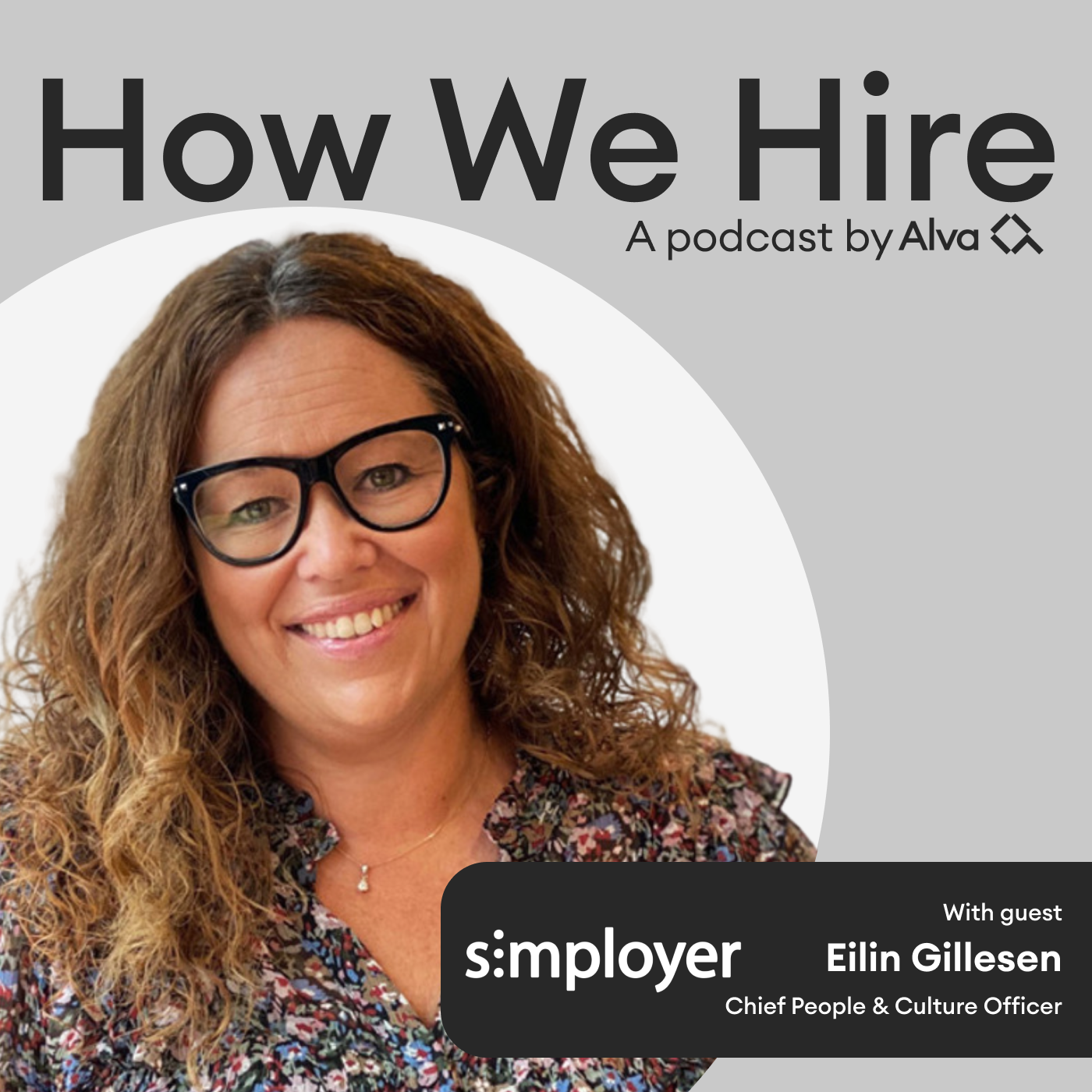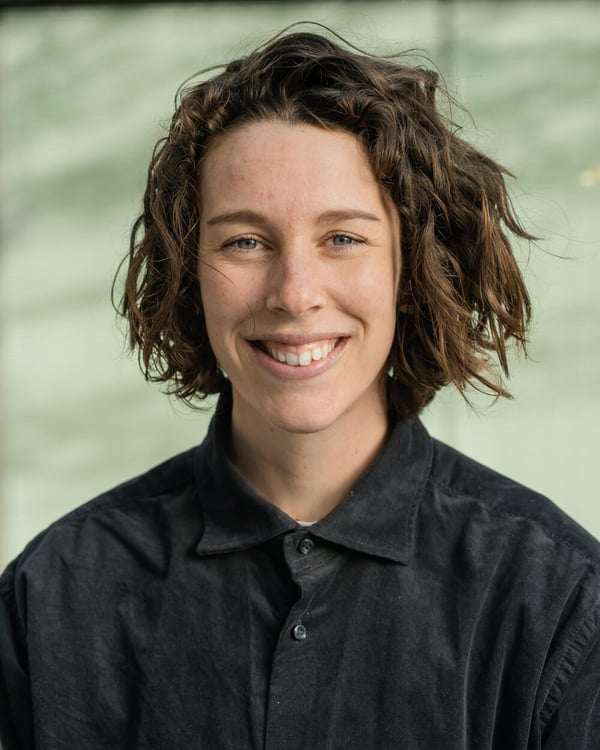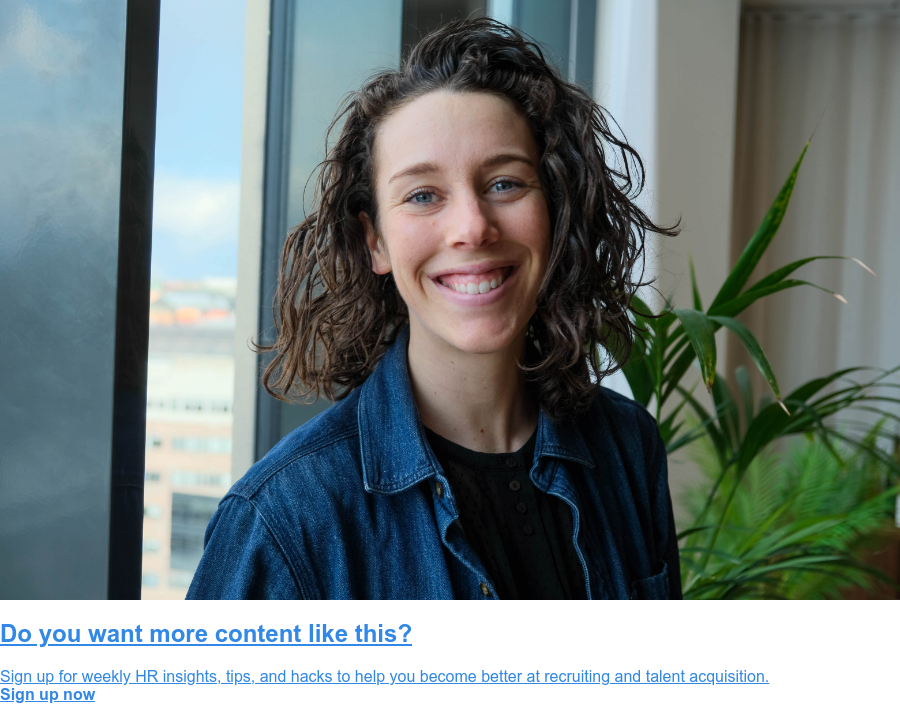How We Hire Podcast: Episode 10 Transcript
Eilin Gillesen (00:00):
We were mainly, I mean Americans in the team, but we were two Swedes. And then my coach came, he's like, "Oh, I signed a new runner." And we were like, "Oh, where's she from? Is she from the US?" And he's like, "No." We're like, "Oh, wow. Where is she from?" "She's from Texas." That was like its own thing.
Linnea Bywall (00:19):
Oh, I love it.
Tove Hernlund (00:35):
Welcome to How We Hire, a podcast by Alva Labs. With me, Tove Hernlund.
Linnea Bywall (00:39):
And me, Linnea Bywall.
Tove Hernlund (00:41):
This show is for all of you who hire or just find recruitment interesting. Every episode we will speak to thought leaders from across the globe to learn from their experiences and best practice within hiring, building teams and growing organizations.
(01:00):
Hi, and welcome to another episode of How We Hire. Our guest on today's episode is Eilin Gillesen. Eilin has over 20 years of senior HR leadership behind her and a passion for helping people and businesses develop. She's currently the Chief People and Culture Officer at Simployer Group, a complete suite of tools for human resources management with a longstanding expertise within the HR sector, she was the perfect fit to reimagine their recruitment processes at Simployer, and today she's here to tell us all about it. So welcome to How We Hire, Eilin.
Eilin Gillesen (01:32):
Thanks. I'm so excited to be here.
Tove Hernlund (01:35):
Yeah, we're really happy to have you here. And first things first, as we said, we'll speak about how you revamped the recruitment process when you started at Simployer. But this is something that you kind of immediately started with. Why was that? What was your initial reasoning behind kicking off your employment by doing this?
Eilin Gillesen (01:54):
Well, there were several reasons for it. First of all, we are a growing company as well. So we are both in Norway, Sweden and Poland. And I quickly discovered that all the countries and managers are doing it differently. And I'm quite passionate about recruitment and finding the right talents. And I know that we need to be somewhat systematic in doing recruitment process in order to make sure that we are hiring the right talents.
(02:22):
So that was two main purposes, to make sure that we are stable in our quality of delivering the recruitment process, but also ensuring that we are hiring the right talents as well. So it was a process where we included all the managers and we did workshops in the different countries to map what the current process is. And after the second workshop, I started sweating really bad because everyone was really doing it very differently. But it was a lot of important learnings from these workshops and we got all the information and then the HR team got together and said, "Okay, so this is the feedback. How would we like the recruitment process to be in Simployer?" We made a proposal and then we took it back to the managers and got their feedback and then it was a thumbs up for our proposal.
Linnea Bywall (03:13):
I obviously want to hear what it looked before, how it looked like after that proposal. How come you decided to really do a bigger process of it, not just go in, like this is how we're going to do it?
Eilin Gillesen (03:25):
It's in my backbone, my philosophy in regards to how we in HR work. I've worked with HR, saying that we have the solution, we'll make the solution and we say tada and then maybe we are not delivering what the managers want or our people want. So I'm really for having an iterative process when we are doing improvements. So it can be times consuming at times. We're not able to do the changes as quick maybe. But I think in the long run it's worth it, especially when we did quite a lot of changes to the process. And it is a process and some people need more time than others to really get accustomed to the processes and the new ideas that we implemented in the process as well.
Linnea Bywall (04:17):
The reason I'm asking is also, I tend to think that HR sometimes overdo the planning of a process and that they don't listen to the organization. And I think this is, it sounds in my mind that you really listen to the organization. But also to your point that it can take too much time. How could there be a sweet spot where you can listen to the organization but also ship fast? What do you think?
Eilin Gillesen (04:46):
I think you need to have different kinds of ways of getting the information, whether it's having workshops, whether it's having a focus group where you have interviews. You can also collect it through data, wherever that might be, whether it be through an ATS system or you run an internal survey. But it's not that we spent a lot of time because it was an hour and a half workshop with each country just getting their feedback. And then we actually spent the time making a proposal based on what we got of information. And then when we made the proposal, we didn't include all the people that had been in the workshops, we selected a few from the different countries.
(05:27):
So in total for our manager it was about two and a half hours. I think the most time consuming was for us in HR to both challenge ourselves and what does research say as well. And then we also had to change our mindsets within HR because we did some changes that a few were more comfortable than others doing the changes. But I think you need to look at what kind of processes that you want to improve and how to get the data so that it doesn't take too long and it doesn't involve too many either. So to be conscious about it, I think that's a important thing.
Linnea Bywall (06:07):
So it sounds like getting feedback internally, taking in some external expert advice and then optimizing for what will work and I guess be accepted by the organization to get you where you want.
Eilin Gillesen (06:20):
Definitely.
Linnea Bywall (06:21):
Okay. So how did it look like before? What did you change?
Eilin Gillesen (06:25):
Depending on who the leader was, it was based on their knowledge and experience from prior. So when we had run all three workshops, I was like, "Oh my goodness, how are we going to revamp this recruitment process?" Because it was just chaos. But when we got together and started systemizing the data that we got, it was more manageable to make the new proposal for the recruitment process as well. So it worked out in the end. We hadn't used testing before. We had been using cases. We had not run structured interviews before. We always did reference checks in our ATS system. We also asked for application letter in addition to CVs. I think this is more normal than not to have all of these aspects. It isn't changing. I can see that also from other companies. So that's what it looked like before we did the revamp. And then afterwards, in our ATS system, we have cut out the application letter. So we only get CVs.
Linnea Bywall (07:36):
And just kind of jumping in, why?
Eilin Gillesen (07:38):
Well, I kind of say that applications letter is like a writing contest for me. It really doesn't give enough value. What kind of information are you getting through it? Those who are really good at writing, they are the ones who are most likely getting through the needle and getting into the process. And it's also not very candidate friendly.
Linnea Bywall (08:02):
Right.
Eilin Gillesen (08:03):
It's very time consuming for the candidates. So we have stopped asking for that. And then we are really looking at the candidate experience the whole way through from they apply to a job until they are done onboarded, which is about six months within their new hires. And then we started with structured interviews. Well, before, let me go back because we also asked ourself where is it that HR can create value? Where in the process is it we can create the value? So we are a small company, we don't have a large HR team. So we said that where we really can make a difference is in the first interview where we are running competency based. Before that interview, we've sent out testing with the Alva Labs. So that's one source of information and then we have a evaluation meeting with the leaders and then decide who goes on to the second interview.
Linnea Bywall (09:08):
So then the first thing that happens is you send me the CV and then you get psychometric assessments, then you get a structured interview with HR.
Eilin Gillesen (09:18):
And the manager.
Linnea Bywall (09:20):
Okay, you do it together. How is that working out?
Eilin Gillesen (09:22):
Really good. Yeah.
Linnea Bywall (09:23):
What are the role division here? Who does what?
Eilin Gillesen (09:26):
Yeah, it's actually HR who's running the interview. When we start the recruitment process, we also have a startup meeting with the manager to agree on the process. But we are actually, this week, going to see how can we use the different capabilities identified in the Alva Labs to use that more as a conversation with the manager. So you now have to choose three to four key capabilities for this role and then use that in the first interview. And then we have that together with the manager and we make an assessment based on these capabilities that we chose, three or four, no more than four because you won't have time to go through more. Then we do the rating and then we pass it on to the manager and someone from the team as well who runs the second interview. And usually it is a case that we present to the candidates and we have also made templates for the managers so that they also can run structured interviews in the second interview.
Linnea Bywall (10:29):
And you said after the application, the assessments, the first interview, you have some sort of discussion with the hiring manager who to proceed with, right?
Eilin Gillesen (10:40):
Yeah. So we do an evaluation together after the first interview.
Linnea Bywall (10:43):
How do you do that?
Eilin Gillesen (10:44):
We go back to the role description and then to the capabilities that we identified. If we said four key capabilities. Okay, so how do we rate this person based on what we said were the key capabilities needed for the role?
Linnea Bywall (10:58):
Do you use only the interview as in, we've already made sure that the background and the personality traits that those are goods, you don't take that into account or do you look at the whole package in that evaluation?
Eilin Gillesen (11:12):
Yeah, we look at the whole package, definitely. Yeah. After the second interviews are done, then we do a new evaluation of the candidates and we always offer the final candidates the opportunity to have informal coffee meetings with members of the team or others that they would like to meet up with.
Linnea Bywall (11:33):
I love that.
Eilin Gillesen (11:34):
Yeah. I think that's just so important so that they get to ask those questions that they maybe forgot to ask or didn't dare to ask in the interview, but also getting a more touched and feel of what kind of culture do we have in this Simployer? What can they expect and can ask a colleague what does a typical day look like. To get a verification also though, okay, this is what he's saying, but what did they tell me in the interview? And is there a match or do I need to have another conversation with their recruiting managers?
Linnea Bywall (12:10):
You won't be able to tell on when you're listening to this podcast, but I'm nodding my head so much that it would borderline it be head banging. I think this is such a easy hack. It takes so little time because it's quite few candidates. You involve the teams that they feel involved in the hiring process. It creates a fantastic candidate experience and it costs nothing.
Eilin Gillesen (12:37):
Exactly.
Linnea Bywall (12:38):
Spoiler alert, we do it too. So that's why I'm so excited to hear that someone else is doing it. But it's so easy.
Eilin Gillesen (12:43):
It is. It's not that every candidate says, "Yes, I would like to do that." But at least to have the opportunity to do it.
Linnea Bywall (12:52):
And then you said you had the structured interview for the hiring manager and then a case. And is that finito?
Eilin Gillesen (12:59):
After the case and then we do a new evaluation with the manager, whoever attended the second interview from our part and then with HR we assess and you we say, okay, so maybe we have two final candidates whom shall get the offer of meeting up with others. And then we give an offer to the candidate and we do not do reference checks.
Linnea Bywall (13:25):
Why?
Eilin Gillesen (13:25):
I am a firm believer that it is our job to find all the information throughout the recruitment process. So contacting references, you usually just get a confirmation of all the good things that the person has done. Rarely do you get any development areas and so forth. There are some exceptions to the rule, but in general, we do not do reference checks because again, what value does it really create into the process?
Linnea Bywall (13:59):
I learned fairly recently that in some countries it's by law you're not allowed to backtalk someone, meaning you can't give a bad reference. I mean that's not the case in at least Sweden. I guess that's the same in Norway. But I think that was so fascinating. Because reference taking will play a complete different part and I agree that it helps to confirm what you hopefully already know.
Eilin Gillesen (14:25):
Exactly.
Linnea Bywall (14:25):
You shouldn't necessarily need that confirmation.
Eilin Gillesen (14:28):
No.
Linnea Bywall (14:28):
Okay. So with this process, what are the biggest changes and how are they perceived by the organization?
Eilin Gillesen (14:36):
I think the biggest change is that we are running structured interviews and also using Alva Labs with the testing, and also systemizing the recruitment process. Now, this is the expectation for the whole process. So we ensure a good candidate experience so everyone understands the roles and responsibilities. And there might be some deviation, but that is clarify when we have the startup meeting with HR.
Linnea Bywall (15:04):
Nice. Because I was about to ask, how do you actually... Because We have a description of this is your part as the hiring manager, this is what HR will do, this is what HR won't do. We have training that can be done if you are new as a hiring manager. But still, how do you really make sure that people understand what's my part, what's not? So you use a startup meeting. How?
Eilin Gillesen (15:30):
Yeah. We've actually made a template for everyone working with recruitment in HR. So we have two TA managers, talent acquisition managers, one who is responsible for Norway and Sweden, and one in Poland. But we also have HR business partners who also do some recruitment. So to make sure that everyone is aligned and making sure that it is as smooth of a process as possible, we made a template for ourselves. And we use that template actively because it's again, challenging on what are the key capabilities for the roles. We assist them in making the job. We made some EVPs for the different target groups as well. We go through the process to clarify who does what during the process, where do we have the job as, what's the salary range. We talk about that already in the startup meeting rather than talking about it at end of the process.
(16:30):
I think we agree that this is a key to success in order to get a smooth of a process as possible because we then also agree, okay, so is this a role that we are able to find talents ourselves or do we need to get help from someone else, a recruitment company or someone. So that's quite important to get that clarified early on in the stage. And we also say that okay, but we would like to try to see if we can do it by ourselves, but let's agree that if we come to this stage then we will look into using recruitment company for example.
Linnea Bywall (17:06):
Okay, what is that stage? What's the signal that you need to go external?
Eilin Gillesen (17:10):
Well, I'm actually recruiting a talent acquisition manager in Poland right now. And what we said that let's post it on our websites and on some of the job portals in Poland and let's have it there for a week and see what the response is and then screen those candidates. And if we feel that yes, we have a lot sufficient candidates, then let's give that a go first. But if it's not sufficient, then we need to discuss what do we do? Do we need to be on other job portals or should we actually do some parallel processes here with getting some assistance on sourcing of candidates from a recruitment company?
Linnea Bywall (17:52):
With so many years of experience within the same sector and sphere, but for very different companies. How similar would you say this new process is to how you worked before or has this been new insights and challenges for you as well to start working like this?
Eilin Gillesen (18:09):
Well I think the main difference is my take on use where HR is making the value in the process. So using the competency based interviews, I think that's something that I had an aha moment a year and a half ago because I work with a colleague who came from the recruitment industry. So I was quite challenged on that and then I tried it and I said, this really makes sense. This is really where I can make a difference, is to the process to make it as smooth as possible is that.
(18:51):
And I think the other change, I've always worked with testing, so that's something that it's just in my backbone to use it as an objective way of screening candidates. But also in regards to not doing reference checks. I've always done it for almost 20 years and then not to do it. But again, it just makes sense when I look back at my career and I ask myself what value did it add? And it's like you said Linnea, it's just a confirmation of what I already know. And if I need that confirmation then it makes sense to do that, but most times I don't.
Linnea Bywall (19:34):
Right. You were stating that how this was being received. Because the structured way of interviewing, at least from my experience, the first initial reaction can be like it's super stiff and me as a manager, I don't want to follow this script. How did your managers react?
Eilin Gillesen (19:52):
Yeah. Well, we're not done yet in implementing it. I think there's a need for a level of maturity in regards to it and we need to also do more training in how to run structured interviews so that they are more confident in how to do it. So we're not there yet, but we are on our way and I think at least our managers, they're quite thankful when they are given some tools. So it's not something that they need to spend time on finding out how to do it or what have you. So we made templates also available for them with different questions that they can use based on what capabilities again are the most important for the role. When we introduce the process in itself, it was applauded, really applauded because they're screaming for who's responsible for what. What kind of support can I expect from HR, for example. What are you expecting from me in this process? So that was the one thing. I think the biggest concern from our managers were more that we are introducing the use of testing.
Linnea Bywall (21:04):
Okay. And how that you convince them around that?
Eilin Gillesen (21:08):
Well, I used our success manager from Alva Labs, Hira, and we had lunch and learns where she introduced what the research say about it. We didn't go into the actual where we showed them the tool, but we gave them the highlights of how to use it because we've said that our managers, not all are doing a lot of recruitment. So let's take that into the start meeting with the different managers. And then we had a separate session where we said, "Okay, so now you've been introduced to it, what are your concerns? What kind of questions do you have?" And just be there and ask them and for them also to be able to share their experiences with the use of testing.
Linnea Bywall (22:00):
What were the questions that they had?
Eilin Gillesen (22:02):
There's a lot of skepticism to the use of it. "What do I get by measuring personality traits or the ability test? I don't see the point of it because it's not relevant for the job." So we had to explain why are we using the ability test for example. So those are the typical things that we really got. "No, I don't see the need to do that."
(22:27):
And also we are a tech company as well, so we got feedback from some of the managers saying that there's quite a scarcity of talents, especially within tech these days. And a talent can have multiple offers at the same time. And they gave us feedback that okay, if you were to say that this candidate needs to take these tests, they're going to say no because they don't have time for that. Then we have to take another round saying that, okay, so are we willing to not send tests then because of urgency? And we've said that we need to evaluate that case by case. But again, it depends on how our ability to explain to the candidates, why are we using testing? It goes both ways. It's also for us to understand if it is the right talent, but also challenging them back, "Are we the right employer for you?"
Linnea Bywall (23:27):
Okay. So it sounds like worrying or wondering if it will be helpful, but also worrying that you might lose candidates if you send tests. What's your experience now then that you used it? Has that been true?
Eilin Gillesen (23:41):
We haven't lost any candidates. Not that I'm aware of at least. But we had a discussion yesterday, again, especially within tech, where in the process do we use the testing? So we need to reevaluate that, especially for the tech target group.
Linnea Bywall (24:03):
Have you seen a difference on this from managers in different countries as well? Have you seen a country discrepancy on how much pushback you're seeing on specifically psychometric tests?
Eilin Gillesen (24:14):
Especially in Poland I would say because it's not customary to use testing that much in Poland. So there, we've spent some time with them also explaining more one on one the usage and what are we getting back in return by using the testing. So more skepticism there because it's not very accustomed to use testing in Sweden, it's worked out really well.
Linnea Bywall (24:43):
Okay. So now you've done this quite massive change to the process. It's now up and running. It sounds like you're iterating on it and always finding ways to improve it. I'm guessing this was a quite big change for the organization and even if they applaud you, what learnings can you share? How does one go about finding a way for this type of change? What are the hacks that you would use if you had to do it again?
Eilin Gillesen (25:10):
I think the key is involving getting the data from those who are actually recruiting, so the managers are key here, and finding ways of getting that information from them so that you understand what does it look like today and where do we want to be and where's the gap. So I think that would be my recommendations to anyone out there looking to revamp the recruitment purposes is to involve those stakeholders that need to be involved.
(25:43):
And we also actually ask some new hires saying that, "You've just been through a process, so how has the process been for yourself?" And we are actually doing that as well. We are sending out surveys on their second day in Simployer to ask about the process from when they applied and the pre-boarding part. And then we're sending him a new survey after six months so that we understand more on the onboarding part. And then obviously, in the pre-boarding survey, we've asked some very specific information about the recruitment process.
Linnea Bywall (26:20):
Like what?
Eilin Gillesen (26:21):
I can't remember all the different questions, but your impression, how do you feel... The response rate from those who are a part of the process. And we also using Jobylon as our ATS system and we are actually using questionnaires there as well for those candidates who have been a part of a recruitment process as well.
Linnea Bywall (26:47):
What recruitment KPIs are you using today? What are you measuring?
Eilin Gillesen (26:54):
We are actually working on it. So we haven't decided yet because we implemented Jobylon in February I think and then we implemented Alva Labs in March. And so we decided let's not focus on the KPIs right now, let's focus on implementing the process and getting that to be smooth. We are just about to look at how the KPIs for recruitment. So in a short while we'll have decided on that.
Linnea Bywall (27:26):
I think that's such an interesting topic. I'm a bit against the traditional time to hire, for instance. To me it's like that's easy to measure so let's measure it, but it says nothing. It says something, but I don't think it says any relevant aspect. We have tried to really measure quality of hire, which is so much harder. But we do that in both evaluating the onboarding progress and then using obviously, the performance reviews that we do three times a year to make sure that we actually make the right decisions. But it's tricky because then the feedback loop is so extended when it comes to hiring. You don't really know maybe a year in.
Eilin Gillesen (28:15):
And I think we also need to remember the candidate perspective as well. So as we are collecting data, so we would actually like to have a KPI also on the candidate experience. That would obviously be subjective, their assessment on it, but that's okay because it also says something about their experience of the quality of how we are doing the recruitment process as well. So I am also not a fan of time to hire because it will vary so differently in regards to the different roles and so forth. But I haven't really cracked a code of how to measure the quality of recruitment yet. So I'll let you know if I figure it out and if you figure out before me promise to share it with me because that really is, if we were able to find the key to that, I think that's meaningful data.
Linnea Bywall (29:10):
I mean that's the holy grail of hiring, right?
Eilin Gillesen (29:12):
Exactly. Yep. Yeah.
Linnea Bywall (29:14):
I'll promise, I'll shout when I find out.
Eilin Gillesen (29:20):
Good. I am hoping that you'll crack the code before myself.
Linnea Bywall (29:24):
Then you don't have to do the work, right?
Eilin Gillesen (29:24):
Exactly.
Linnea Bywall (29:24):
Smart.
Tove Hernlund (29:24):
I'll do my best.
Linnea Bywall (29:29):
As you said, you're focusing a lot on the candidate experience and that was your whole take when you started revamping the process too, to make sure that it was structured and aligned and looked the same and that the candidates' experience was always good. But you also had a really heavy focus on employer branding in this. How has that changed since you implemented this new process?
Eilin Gillesen (29:50):
Well, we focused first on implementing the recruitment process and since then we have worked on finalizing our employee value proposition, and we have done that. And then we actually had rounds of defining personas for the different target groups. And then again we involved... So for example, if we took within the tech, we had a short workshop with some of our tech colleagues to get their feedback on what is important for them when they were hired to Simployer. So now we have made personas for the different target groups. That's going to be quite important for us. So what are we focusing on, for example, for sales or product or tech. And I think that will be a key also to be able to attract the right and qualified candidates also because we are more targeted than we were before because we would have it a general information about Simployer and then you would go straight to the wanted outcomes for the role. But now we're stating the EVP quite high, or going to do that in our job ads. We're just about to implement that as well.
Linnea Bywall (31:04):
My imposter syndrome is so large right now. You have so much more experience than me and I don't know that much about employer branding and I really want to understand how does one actually go about making those changes? What concretely have you done that is now different?
Eilin Gillesen (31:23):
Well, what we have done is we have started with the EVP. And it is a process because again, we either us or communication or marketing can say make some texts to us and say, "Yes, here we have the EVP first Simployer." But we collected all the data we could get from engagement surveys that we had implemented the core story first Simployer with a lot of information from our employees. And then we actually used a Gartner model for employer branding that I highly suggest. And then we made the personas as well. So HR made the first draft for the personas and then we went out to our colleagues getting them to verify if we were spot on or not and what is it that they value by working within Simployer.
Linnea Bywall (32:21):
Does that mean okay, we listen to the organization, what are we good at? So that you would be able to highlight that in the EVP. You made these personas. What were in them? I'm taking notes now.
Eilin Gillesen (32:33):
Yeah, well we had to decide what are the key aspects that we would like to focus on. What is it that our people really value? They value flexibility, balance, growth. So those are the things that we are focusing on, on the EVP. But for the different personas, you need to have different focus. So maybe growth is more important for tech than product, for example. Maybe balance or flexibility is more important. So that's how we are adjusting the personas in regards to again, who the target group is.
(33:10):
So we started with the EVP and we are connecting that to the marketing strategy, to our core story of Simployer. And now we are about to finalize a more long term work with employer strategy looking into, so what kind of strategic partnerships will be important for this Simployer going forward so that we can attract the right talents. What can we do to get focused on ourselves? We will be having some marketing campaigns, not from a customer perspective, so that we can tell everyone about Simployer as a employer. In Norway especially, we are really well known by customers, but not necessarily of talents.
(33:59):
We are revamping our career sites, getting new, fresh pictures of our employees trying... I think the key is to be able to, and this is the difficult part, is what kind of culture do we have here at Simployer? Because in all the research that I'm finding is that the culture is top three for what people are looking for in a new employer. So that's what we are trying, we're going to make more videos, for example. Both videos to have on our websites, we also have some videos that we send to candidates also when they are in process so that they somehow get more of a touch and feel of what would it be like to work in Simployer.
Linnea Bywall (34:50):
And what's the ultimate goal of this? Is it to move candidates faster in the hiring funnel? Is it to find other type of candidates? Is it just volume, the amount of candidates that apply? Is it quality? What do you think? What's the ultimate ambition?
Eilin Gillesen (35:09):
Can I choose all of the above?
Linnea Bywall (35:11):
Yes.
Eilin Gillesen (35:13):
So it is a combination of all of the above, for sure. But I think with the scarcity of talents in the market currently, it's about finding the right... We don't need a lot of applicants, but we need the right applicants, those who are qualified for the roles. And I think it's interesting, are we hiring for attitudes or are we hiring for skills as well? And I think one of the key aspects when hiring talents is their ability to learn. That will be a key capability going forward.
Linnea Bywall (35:52):
If someone else is standing in front of the same journey that you've been on, meaning we need to revamp the hiring process, we need to take a step on the employer branding, what would you advise them to do and not do?
Eilin Gillesen (36:11):
That's quite a big question. Well, I think in regards to revamping, you actually need to use the methods of a project lead, project management, to decide who are your stakeholders, what kind of information do we need in order for us to make good decisions for the future. And then actually make a good project plan for that. The same would actually be for the employer branding, but I would say that the key to a successful employer branding strategy is making the EVP. So if you start with the EVP, it's so much easier to decide on the rest because then you will always look to the EVP saying that, okay, but are we delivering now on our EVP, if we do that and so forth. And again, look to the Gartner model for employer branding because it's easy to follow the framework that they have.
Linnea Bywall (37:13):
And what are the don'ts.
Eilin Gillesen (37:16):
Don't sit in corner of the office and just make everything by yourself. I think it's so important to involve those who need to be involved. Depending on how big are the changes that you will have, don't underestimate the need of spending some extra time in the process, training. The leaders, so I think that's really important to spend enough time on the leaders so that they are capable of doing a recruitment process well. So don't underestimate their needs. That's something that I sometimes have tendency to do. So I would say that's a big don't. I think that's the most important, on the top of my head right now.
Linnea Bywall (38:05):
I have one more question before we go, given that we both lived in Texas.
Eilin Gillesen (38:10):
Okay.
Linnea Bywall (38:11):
Then the obvious question is, are you finding a good place we can get cornbread in Norway?
Eilin Gillesen (38:17):
No.
Linnea Bywall (38:18):
It's impossible, right?
Eilin Gillesen (38:19):
It's impossible. I've heard some rumors that there's a newly open restaurant that has the good old briskets and everything. So we have it on our to-do to see if they actually have good cornbread.
Linnea Bywall (38:34):
Yeah, I'm still looking for good cornbread and baby back ribs with Texas quality.
Eilin Gillesen (38:39):
The next time you come to Oslo, I'll invite you for dinner.
Linnea Bywall (38:43):
Amazing. So then the feedback loop will be then when we solve the holy grail of hiring quality, and when we find the perfect baby back ribs. That's next. Best next episode of How We Hire.
Tove Hernlund (38:56):
Thank you so much for joining us today, Eilin. It's been such a pleasure having you. Me and Linnea will be back with another exciting episode of How We Hire in two weeks. So make sure to subscribe via Spotify or Apple Music to never miss another episode.







